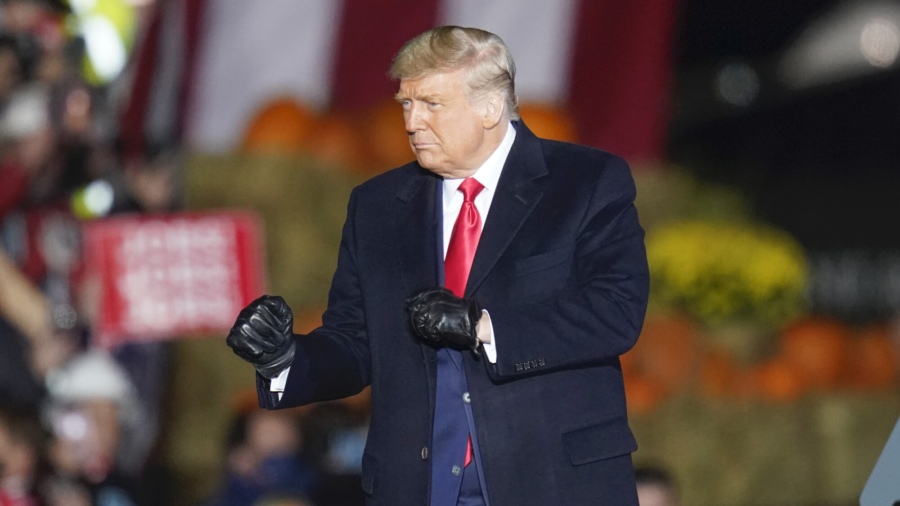President Donald Trump on Sunday launches his final, two-day sprint of campaigning across the battleground states of the 2020 election.
On Sunday and Monday, Trump will stage 10 rallies—five a day—making it the campaign’s busiest stretch. He aims to generate enough momentum to drive an overwhelming turnout by his supporters on Tuesday, Election Day.
On Sunday, the president will hold rallies in Michigan, Iowa, North Carolina, Georgia, and Florida. On Monday his campaign has scheduled events in North Carolina, Pennsylvania, and Wisconsin, and two in Michigan.
He will close out the two-day swing with a late-night rally on Monday in Grand Rapids, Michigan, the same location where he finished his campaign in 2016. In his victory four years ago, he took Michigan, Pennsylvania, and Wisconsin, three states that for decades had gone in the Democratic column.
Trump is turning to rallies to help keep his message in front of voters.
“Let me ask you, is there a better place to be anytime, anywhere than a Trump rally?” Trump asked a massive crowd Saturday in Butler, Pennsylvania, that responded in roaring approval.

With more than 91 million votes already cast, Trump and Biden are focusing on their bases and making sure that any potential supporters have either already voted or plan to do so in person on Tuesday.
For Biden, that means paying close attention to black voters, who are a critical part of the coalition he needs to build to win. His team is confident in Biden’s standing with women, college-educated voters and those who live in the suburbs.
But some Democrats worry that voters of color may not be excited about Biden and won’t show up in force to support him, which could be devastating in fiercely contested battleground states like Pennsylvania and Michigan.
The challenge is exacerbated by the Democrats’ push this year to encourage voting by mail to prevent people waiting in long lines during a pandemic. But that runs counter to the tradition of some black voters who prefer to vote in person on Election Day.
“Most Black voters in Philly have been skeptical of mail-in voting,” said Joe Hill, a veteran Democratic operative-turned-lobbyist from the city. “A lot of us have gotten our ballots already,” Hill said, but added, “Election Day has always been everything in Philadelphia.”
Biden will spend much of Sunday in Philadelphia encouraging voters to turn out. He’ll participate in a “souls to the polls” event that’s aimed at encouraging black church congregations to organize and vote.

He held his first in-person campaign events with former President Barack Obama on Saturday in the predominantly black cities of Detroit and Flint, Michigan. Obama will also campaign for Biden on Monday in Georgia and in South Florida, another area of potential concern if Latino voters sit out the election.
As the largest city in a state that could decide the presidency, Philadelphia has always held special significance for Biden. Just 30 miles from his longtime home in Wilmington, Delaware, Biden planted his campaign headquarters in Philadelphia before the pandemic forced most of his staff to work remotely.
The city gets intense focus because it’s such a deep trove of Democratic votes, especially non-white voters.
Democrat Hillary Clinton lost Pennsylvania by almost 45,000 votes four years ago even as she fell just 4,800 votes shy of Obama’s Philadelphia County total in 2012. Clinton’s bigger problem was that she lost ground to Trump in other parts of the state beyond Philadelphia and its suburbs.
According to an analysis by University of Florida professor Michael McDonald, a nonpartisan political data expert, almost 2.3 million Pennsylvania voters had returned absentee ballots as of Friday out of almost 3.1 million requested. That’s a statewide return rate of 74.2 percent.
Philadelphia’s return rate was a tick higher, at 74.6 percent, but it had the highest raw total of outstanding ballots, with more than 101,000. Statewide, registered Democrats maintained a solid advantage over Republicans on returned ballots: 1.54 million to about 520,000. In a separate analysis, the Democratic data firm TargetSmart found that more than 385,000 of the early Democratic voters didn’t vote at all in 2016.
Across the state in Pittsburgh, Democratic consultant Mike Mikus stressed that Philadelphia isn’t Biden’s only path to flipping Pennsylvania. Mikus noted that Trump won a Pittsburgh-area congressional district by nearly 20 percentage points in 2016 only to watch Democrat Conor Lamb win a special congressional election there a year later. Lamb won a full term in 2018 and is heavily favored again Tuesday.
Mikus said that trend will help Biden run up a wide margin in Allegheny County, the state’s second most populous.
“He’s got a real base, but there’s just no evidence that he’s done anything to reach anybody who didn’t already like him in 2016,” Mikus said, “and he’s lost people who weren’t sure about him but were willing to take the gamble. … It’s not just about Philadelphia.”
Reuters contributed to this report.


